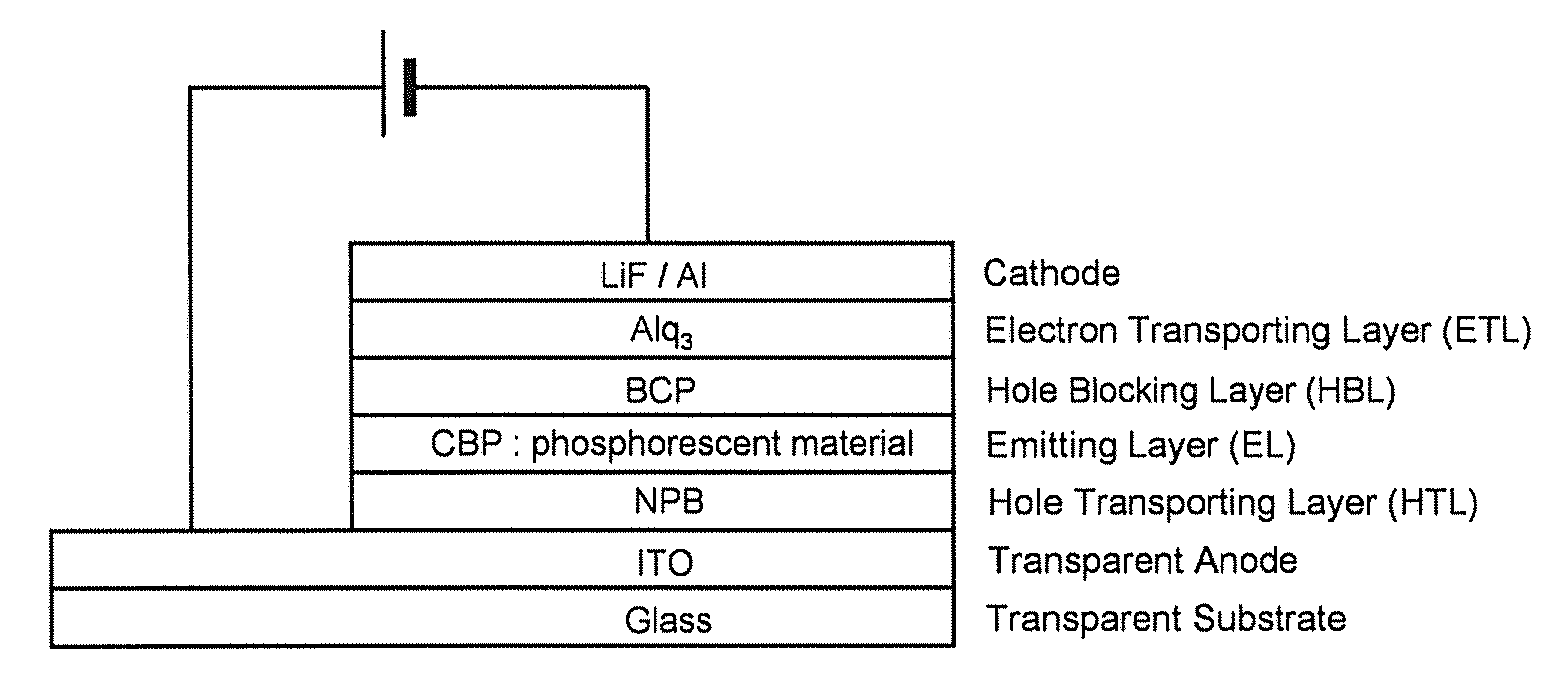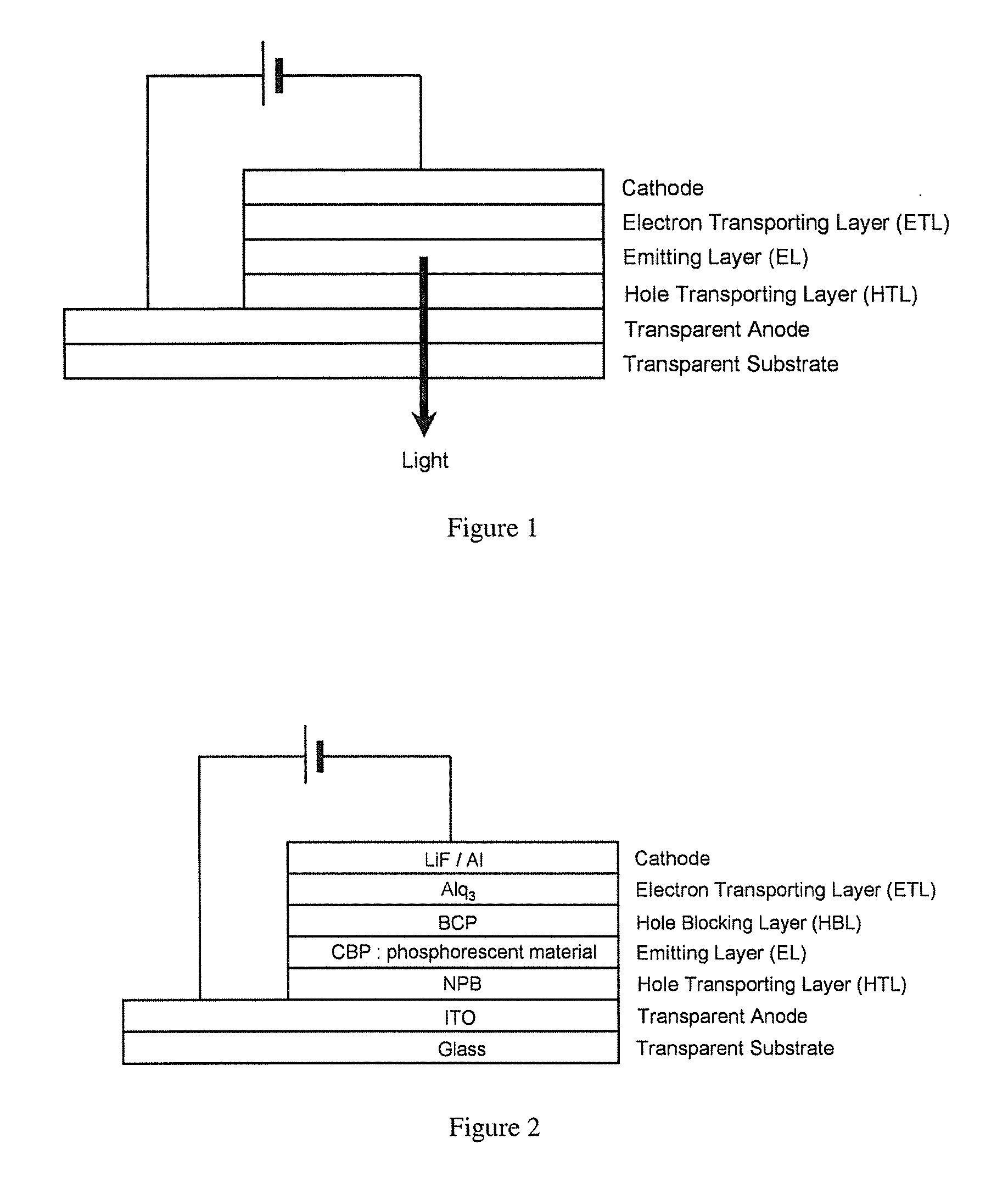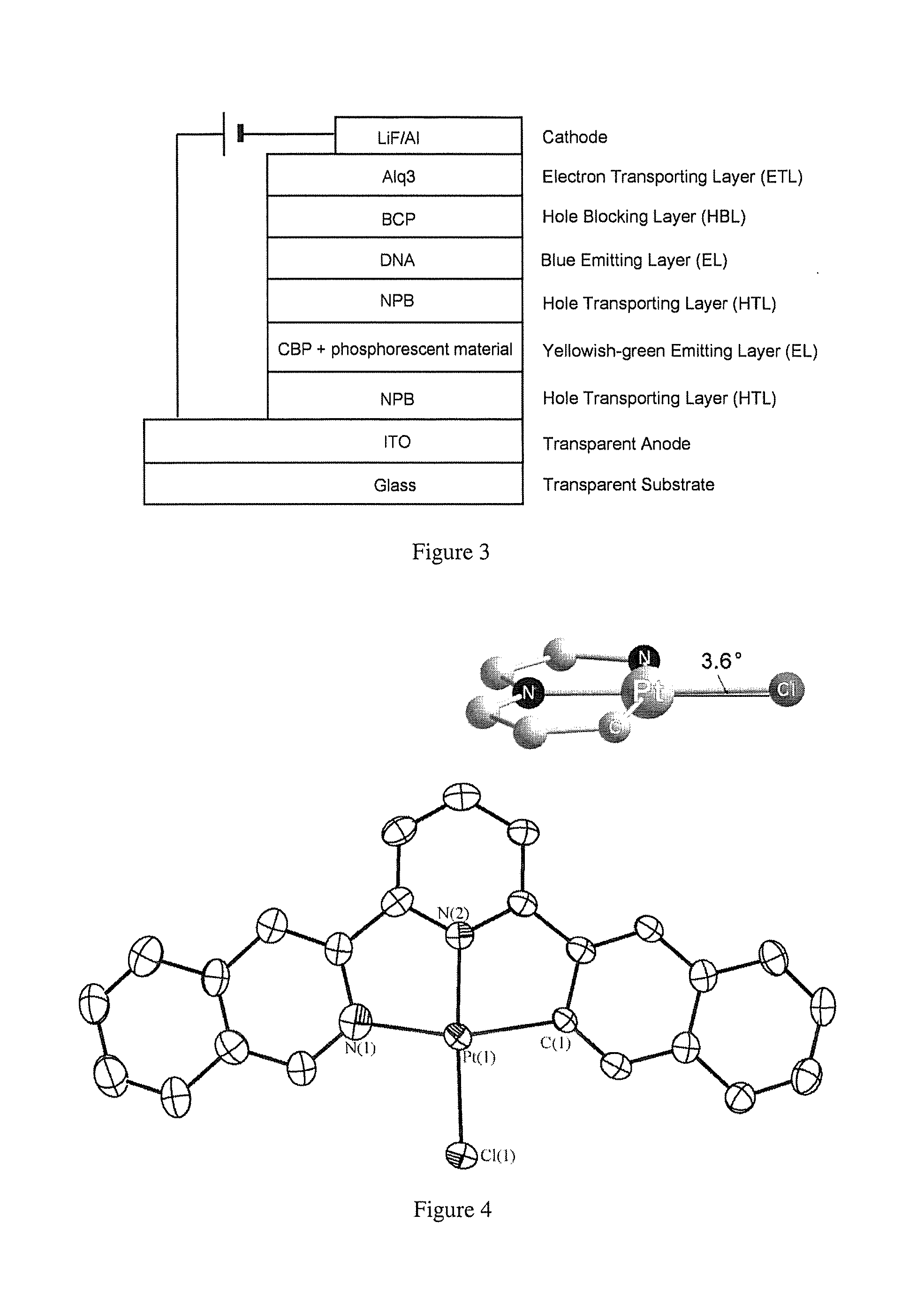Extended pi-conjugated platinum (II) complexes
a piconjugated platinum and complex technology, applied in the direction of platinum organic compounds, luminescent screens of discharge tubes, organic chemistry, etc., can solve the problems of emitted from the triplet state and the quantum efficiency of an electrofluorescence device is typically limited
- Summary
- Abstract
- Description
- Claims
- Application Information
AI Technical Summary
Problems solved by technology
Method used
Image
Examples
example 1
[0077]Example 1 describes the synthesis of Ligand 1 and complex 1:
(a) The Synthesis Method and Physical Characterizations of Ligand 1:
[0078]
[0079]3-acetylisoqulinoline was prepared from 3-hydroxyisoqulinoline using a Heck reaction (J. Y. Legros et al., Tetrahedron 57: 2507 (2001)). 1-(2-oxo-2-(3′-isoquinolinyl)ethyl)pyridinium iodide was prepared by heating 3-acetylisoqulinoline with excess 12 in pyridine for 2 hours (R. G. Pearson, J. Am. Chem. Soc. 69, 3100 (1947); L. C. King et al., J. Am. Chem. Soc. 70, 239 (1948)). 3-dimethylamino-1-(2′-naphthyl)-propanone hydrochloride salt was synthesized by refluxing 2-acetylnaphthalene, paraformaldehyde and dimethylamine hydrochloride in the presence of conc. HCl in 95% ethanol for 24 hours (F. F. Blicke et al., J. Am. Chem. Soc. 64, 451 (1942)).
[0080]Heating 1-(2-oxo-2-(3′-isoquinolinyl)ethyl)pyridinium iodide (1.00 g, 2.66 mmol), 3-dimethylamino-1-(2′-naphthyl)-propanone hydrochloride salt (0.70 g, 2.7 mmol) and ammonium acetate (5.00 g, ...
example 2
[0085]Example 2 describes the synthesis of Ligand 2 and Complex 2:
(a) The Synthesis Method and Physical Characterizations of Ligand 2:
[0086]
[0087]3-acetylisoqulinoline was prepared from 3-hydroxyisoqulinoline using Heck reaction (J. Y. Legros et al., Tetrahedron 57: 2507 (2001)). 1-(2-oxo-2-(3′-isoquinolinyl)ethyl)pyridinium iodide was prepared by heating 3-acetylisoqulinoline with excess 12 in pyridine for 2 hours (R. G. Pearson, J. Am. Chem. Soc. 69, 3100 (1947); L. C. King et al., J. Am. Chem. Soc. 70, 239 (1948)). α,β-unsaturated ketone (tert-butylidene-2-acetonaphthone) was prepared according to the approach described in G. W. V. Cave et al., J. Chem. Soc., Perkin Trans. 1, 3258 (2001); F. Neve et al., Inorg. Chem. 36, 6150 (1997), for example.
[0088]Heating 1-(2-oxo-2-(3′-isoquinolinyl)ethyl)pyridinium iodide (0.47 g, 1.3 mmol), tert-butylidene-2-acetonaphthone (0.30 g, 1.3 mmol) and ammonium acetate (5.00 g, 64.9 mmol) in methanol (100 mL) for 24 hours gave crude Ligand 2. The...
example 3
[0093]Example 3 describes the synthesis of Ligand 3 and Complex 3:
(a) The Synthesis Method and Physical Characterizations of Ligand 3:
[0094]
[0095]3-acetylisoqulinoline was prepared from 3-hydroxyisoqulinoline using a Heck reaction (J. Y. Legros et al., Tetrahedron 57: 2507 (2001)). 1-(2-oxo-2-(3′-isoquinolinyl)ethyl)pyridinium iodide was prepared by heating 3-acetylisoqulinoline with excess 12 in pyridine for 2 hours (R. G. Pearson, J. Am. Chem. Soc. 69, 3100 (1947); L. C. King et al., J. Am. Chem. Soc. 70, 239 (1948)). α,β-unsaturated ketone (benzylidene-2-acetonaphthone) was prepared according to the approach described in G. W. V. Cave et al., J. Chem. Soc., Perkin Trans. 1, 3258 (2001); F. Neve et al., Inorg. Chem. 36, 6150 (1997), for example.
[0096]Heating 1-(2-oxo-2-(3′-isoquinolinyl)ethyl)pyridinium iodide (1.00 g, 2.66 mmol), benzylidene-2-acetonaphthone (0.69 g, 2.7 mmol) and ammonium acetate (5.00 g, 64.9 mmol) in methanol (100 mL) for 24 hours gave crude Ligand 3. The crud...
PUM
 Login to View More
Login to View More Abstract
Description
Claims
Application Information
 Login to View More
Login to View More - R&D
- Intellectual Property
- Life Sciences
- Materials
- Tech Scout
- Unparalleled Data Quality
- Higher Quality Content
- 60% Fewer Hallucinations
Browse by: Latest US Patents, China's latest patents, Technical Efficacy Thesaurus, Application Domain, Technology Topic, Popular Technical Reports.
© 2025 PatSnap. All rights reserved.Legal|Privacy policy|Modern Slavery Act Transparency Statement|Sitemap|About US| Contact US: help@patsnap.com



